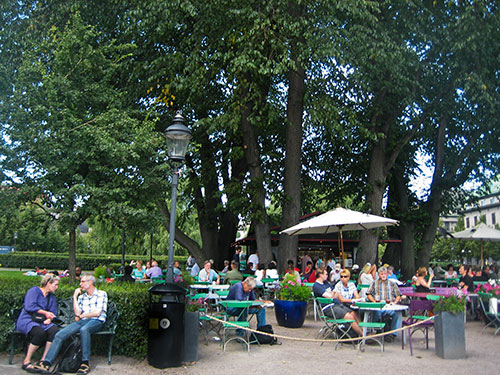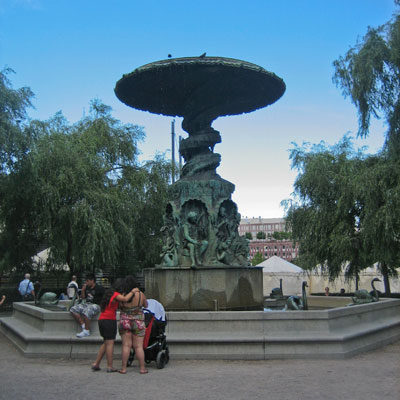

Kungsträdgården
Kungsträdgården is an oasis in the middle of Stockholm where people come to eat, associate and relax. It's sometimes called the "Stockholm's living room" which is a good description.
There are plenty of restaurants and cafés and on the stage there's frequently offered entertainment. During the winter, a part of Kungsträdgården turn into a popular skating rink.
A popular place for some coffee or a meal, is the terrace Tehuset. It lies nestled under the elms and have a view over Strömkajen and Kungliga slottet.

At 1971, there wasn't as calm as it 'd been before. There was a big fight about the elms (you see the trees in the picture above). The Stockholm's politicians, with Mayor Hjalmar Mehr at the top, had decided to build a subway entrance right where the elms stood with it's glory.
And they would surely have built the subway entrance if not a huge amount of people would've protested. For several days, there were people hanging in the tree to prevent the tree huggers to chop it down. At last the politicians had to give up, the will of the people won and the elms could stand there alone without getting chopped down. (the subway entrance was built on Arsenalgatan instead).
Tourists and people from Stockholm are very thankful for this today.
Café Söderberg, which is located on the park's western long side, is named after the writer Hjalmar Söderberg. Earlier there was a water store and this was the place where Pastor Gregory was murdered, in Söderberg's famous novel "Doktor Glas".
In the middle of Kungsträdgården there's a fountain called Molin's fountain. The fountain depicts Näcken who plays for King Agir and his daughters, a motive from the Norse mythology. The fountain was first made in plaster for the art- and industrial exhibition in Stockholm in 1866, but was such a success that it a few years later was remade in bronze.

Kungsträdgården was from the beginning a place only for the royal and was surrounded by a wall. Ordinary people didn't bother. But towards the end of the 1700s Kungsträdgården was open for everyone and the wall was taken down in 1800.
From 1642, the Palace Makalös was placed in the part of Kungsträdgården that was facing the water. It was built by Jakob de la Gardie and was, according to descriptions, one of the Stockholm's most pompous buildings.
In 1792, the castle was rebuilt to a dramatic theater, but the joy was rather short. During a performance in 1825, the palace burned down under dramatic circumstances. Three people were killed but the rest were rescued from the sea of fire, which must be seen as a minor miracle.
Read more about Kungsträdgården at Kungsträdgården's own website

